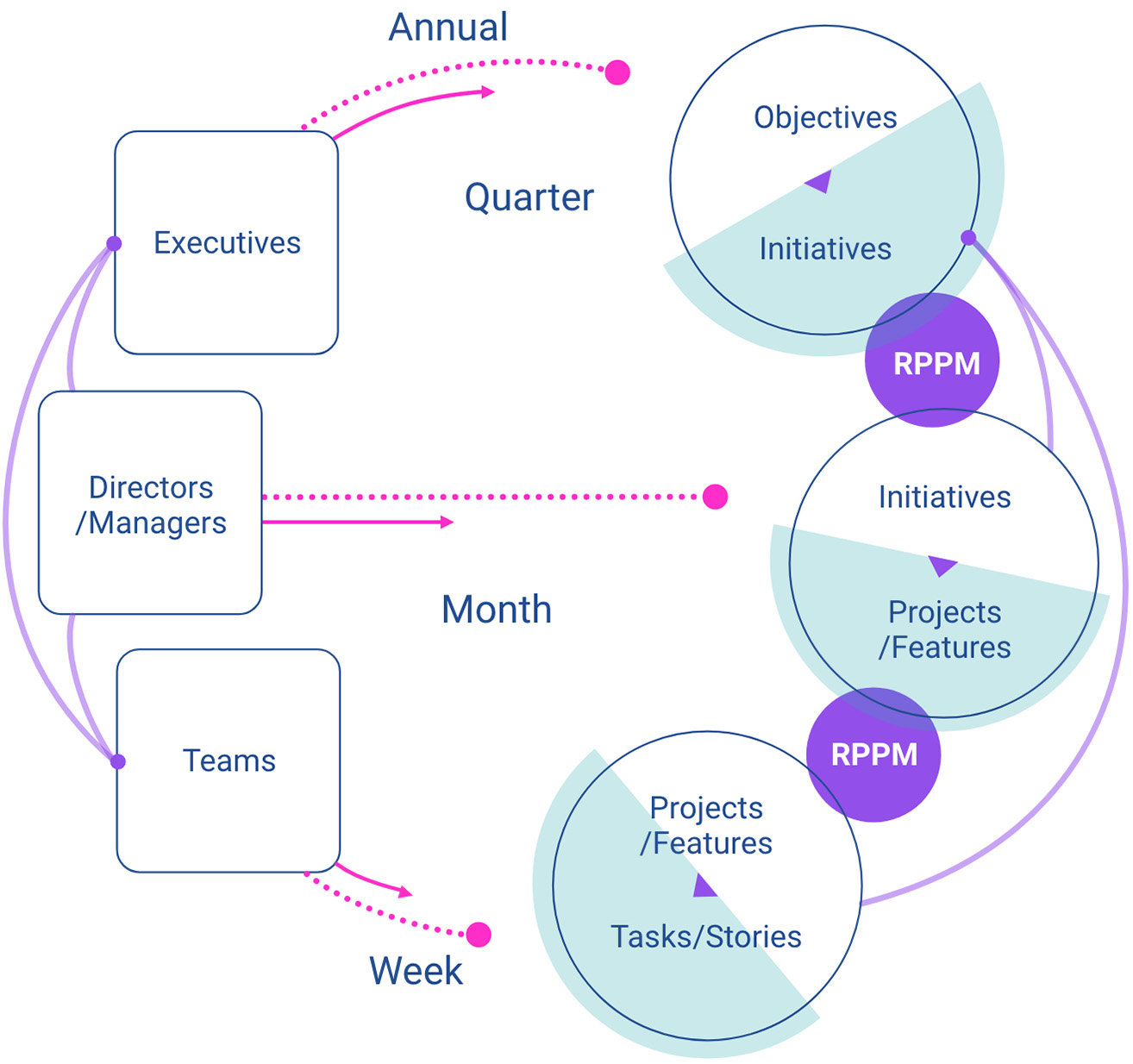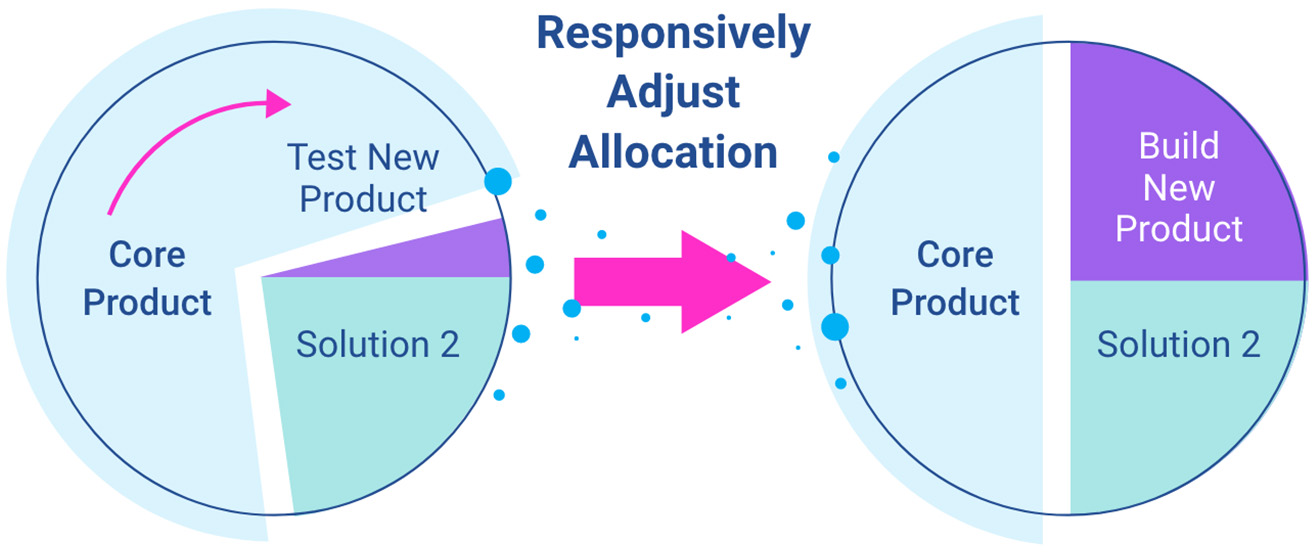Responsive Product Portfolio Management: A Dynamic Approach to Accelerating Outcomes
Responsive Product Portfolio Management (Responsive PPM) is a strategic framework designed to help product-centric organizations connect business objectives, customer needs, products, and resources with execution in real-time. By emphasizing flexibility and adaptability, Responsive PPM enables organizations to accelerate portfolio outcomes and ensure that their product portfolios remain aligned with evolving market conditions and customer expectations.
Unlike traditional Project Portfolio Management (PPM), which tends to focus on a static collection of projects with centralized governance, Responsive PPM emphasizes a more dynamic approach. This framework encourages portfolio leaders to continuously evolve products and adapt their strategies based on real-time data and feedback. The goal is to deliver customer delight and drive business outcomes more effectively.
Many successful companies—such as Miro, Procore, PayPal, eBay, Shutterfly, and BigCommerce—have adopted the Responsive PPM approach to optimize their product portfolios and enhance their ability to respond to changing market demands.
What is Responsive Product Portfolio Management?
Responsive Product Portfolio Management (Responsive PPM) is a strategic framework that aligns a company’s products and resources with the overall business strategy. It’s built on the premise that product development and portfolio management need to be flexible and responsive to both customer needs and market changes. Instead of treating a portfolio as a fixed set of projects, Responsive PPM views it as a constantly evolving set of products that require continuous adaptation and real-time decision-making.
Responsive PPM integrates multiple aspects of portfolio management, from strategy to execution, with an emphasis on making data-driven decisions, balancing short-term objectives with long-term vision, and ensuring that all teams are working toward common goals. This framework empowers Chief Product Officers (CPOs), Product Operations Leaders, and Portfolio Management Executives to adapt and adjust their product portfolios on the fly, ensuring that they remain responsive to customer demands and business objectives.
5 Key Principles of Responsive Product Portfolio Management
Responsive PPM is built upon five essential principles that guide portfolio leaders in creating more adaptive and outcome-focused product strategies. These principles are designed to ensure that product portfolios are continuously aligned with customer needs and business priorities.
1) Multi-Dimensional Product Portfolios
Traditional PPM tends to view portfolios through a single lens—usually based on project completion or ROI. In contrast, Responsive PPM embraces a multi-dimensional approach, evaluating portfolios through various dimensions like customer impact, market trends, technology, and business goals. This perspective allows for a more comprehensive and flexible view of a portfolio, helping organizations prioritize initiatives that will deliver the most value across different dimensions.
2) Three Operating Horizons
Responsive PPM divides the product portfolio into three distinct operating horizons:
- Horizon 1: Focuses on core products and short-term initiatives that drive immediate value.
- Horizon 2: Focuses on adjacent innovations and medium-term opportunities that extend the portfolio’s capabilities.
- Horizon 3: Focuses on disruptive innovations and long-term strategic goals that shape the future direction of the portfolio.
By managing products across these horizons, portfolio leaders can balance short-term deliverables with long-term strategic vision, enabling sustainable growth.

3) The Double-Diamond of Strategy and Execution Workflow
The Double-Diamond framework emphasizes the need for two distinct phases:
- Discover: During this phase, product teams focus on understanding customer needs, exploring opportunities, and gathering insights.
- Define: The second phase involves refining and prioritizing these opportunities, aligning them with business goals, and preparing them for execution.
The Double-Diamond approach ensures that product teams remain focused on both strategic alignment and execution excellence.
4) MoAR Replacing ROI to Assess Opportunities
Instead of relying on traditional ROI (Return on Investment) to assess the potential of product initiatives, Responsive PPM uses MoAR (Metrics Over Available Resources). MoAR focuses on a broader set of indicators, such as customer satisfaction, product adoption, market share, and long-term business impact, to determine the value of opportunities. This approach allows product leaders to evaluate initiatives beyond just financial return and make more informed, holistic decisions.
5) Responsive Portfolio Adjustment
One of the key elements of Responsive PPM is the ability to continuously adjust the portfolio based on real-time data, feedback, and changing market conditions. This principle emphasizes the importance of flexibility—ensuring that product leaders can pivot quickly when new information emerges or when business priorities shift. By remaining responsive, organizations can adapt to changing customer needs and business challenges without disrupting the overall strategy.

Why is Responsive PPM Important?
Responsive PPM offers several advantages that traditional PPM frameworks often lack:
- Adaptability to Change: In fast-moving industries, market conditions, customer preferences, and technologies can shift rapidly. Responsive PPM helps organizations remain agile, allowing them to adjust their product portfolios and strategies in real-time, minimizing risk and maximizing opportunity.
- Focus on Customer and Business Outcomes: Unlike traditional PPM—which may concentrate on project milestones or internal processes—Responsive PPM centers on delivering both customer value and measurable business outcomes. By continuously aligning product portfolios with evolving customer needs and overarching business objectives, organizations not only enhance customer satisfaction but also drive revenue growth, market share, and long-term success. This dual focus ensures that every strategic decision supports immediate customer delight while contributing to the company’s broader strategic vision.
- Holistic Product Management: The multi-dimensional approach and three horizons principle in Responsive PPM allow product leaders to manage their portfolios with a broader view of both current and future opportunities. This helps organizations balance innovation with core product enhancements, ensuring long-term growth.
- Increased Cross-Functional Alignment: With a focus on continuous feedback and alignment, Responsive PPM fosters better collaboration between product, engineering, marketing, and other teams. This results in more streamlined execution and better outcomes across the portfolio.
Conclusion
Successful companies like Miro, Procore, PayPal, eBay, Shutterfly, and BigCommerce have embraced Responsive PPM to manage their product portfolios. These organizations have leveraged the framework to drive more responsive and adaptive product development, ultimately accelerating outcomes and improving business performance.
For Chief Product Officers, Product Operations Leaders, and Portfolio Management Executives, implementing Responsive PPM helps deliver better product outcomes, reduces wasted effort, and ensures that teams are working toward strategic goals that drive both customer and business success.
For more information on Responsive PPM, visit the Responsive PPM, the fastest-growing community for outcome-focused product teams, and get certified.